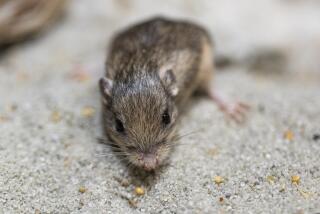Not Just Some Guinea Pig : Genetically compatible. Easy to feed. Mice are the lab animals of choice, and what we’relearning could make us healthier--and thinner.
- Share via
All right folks, let’s hear it for the Mighty Mutant Mouse, unsung super-hero of the science world, magnificent (though chinless) mammal who made possible last week’s stirring announcement that a “thin” hormone has been discovered in mice that may, when injected into humans, cause the quick disappearance of excess body fat.
Dr. Jeffrey Friedman, molecular geneticist at the Howard Hughes Institute at Rockefeller University in New York, worked nearly a decade to find and isolate the hormone in his ob (for obese) lab mice, and of course he got all the public credit: newspaper interviews, TV appearances on top-rated shows, probably a few extra dollars in his paycheck.
And if he said he couldn’t have done it alone, most would assume he meant his human colleagues.
Insiders would know he meant mice, the creatures of choice for the vast majority of biomedical researchers.
In fact, descendants of Mus musculus, the common house mouse, have easily become the most valuable, efficient and practical animal models in biomedical research, capable of leading to incredible discoveries.
“We are at the beginning of a genetics revolution, which is accelerating the pace of discovery. In the next 10 years we will learn more about how our bodies work and about human disease than we have in all of previous history--all courtesy of the mouse,” says Dr. Kenneth Paigen, director of the prestigious Jackson Laboratory in Bar Harbor, Me.
The Jackson Lab is the world’s foremost institution for studying mouse models of human disease, and the country’s largest repository of mutant mice shipped around the world for use in medical research.
Friedman’s ob mice were from Jackson Lab--the original born there more than 20 years ago.
The strain was kept alive and pure by mating dozens of successive generations of brothers and sisters descended from the original, so that today’s mice, such as the ones on which Friedman worked, are virtually identical genetic carbon copies of each other.
In 1991, the usually sedate Harvard Health Letter waxed rhapsodic about the rodents. In its annual list of the 10 most important health advances--a list usually composed of new diagnostic procedures and new therapies for disease--the letter proclaimed that “The Decade of the Mouse” had begun, and that the mouse had become easily the most powerful experimental system we have for mammalian research.
Why the mouse?
Let’s set the record straight. Despite its soprano squeak and its tiny body shaped like an Anjou pear, the mouse is as much like humans as any other mammal, genetically speaking, Paigen says.
“Mice are terrific because they are like us. They have very much the same genes that people and all other mammals do,” he adds. “They have the same physiological systems--digestive, nervous, immune, circulatory, et cetera--so it’s hardly surprising that they get the same diseases we do.”
Added to that, he says, is the fact that “we know more about the genetics of the mouse than we do any other mammal, even ourselves,” because mice have been the prime animal in the study of genetics in mammals for over 100 years.
Because the identity, the order and the arrangement of genes on chromosomes has been so well mapped in the mouse, and is so nearly identical in humans, scientists can discover a gene in a mouse and accurately predict its location on a corresponding human chromosome. And vice versa.
This was all very helpful, but not exactly revolutionary until about 15 years ago, when researchers figured out a way to add a gene to a mouse--and then study the results.
Then about five years ago, Paigen says, scientists devised a way to knock out an existing good gene in a mouse and replace it with a bad one. Or add a novel gene.
These transgenic mice, colloquially called “knockouts,” are the stuff that cures for disease are made of.
As mouse researcher Julie Anderson, an assistant professor at USC explains it: “People with a genetic disease have a mistake in the DNA that encodes a particular gene that is passed from generation to generation. Scientists first try to figure out where the error is in the DNA, where it is different from so-called normal people.
“They find the mistake, and they are able to put it into mice who are part of a group that are genetically identical. Then they compare the mice that have the mutation with those who have not been given the defective gene.
“Now the mouse has the disease, and we can look at the progression of the illness, and try different therapies.”
Besides their genetic compatibility, mice are small, easy to move, and inexpensive to maintain.
But some object to their use.
“Mice are like us in that they feel pain and fear and value their lives--that’s why it’s unethical to use them,” says Ingrid Newkirk, founder of the People for the Ethical Treatment of Animals, based in Rockville, Md. “But they are not like us in many physiological respects. They are used [in research] because they are cheap, easy to handle and evoke very little public sympathy.”
Andersen, however, says the possibilities of their use are wondrous.
In the case of Alzheimer’s, for example, “If we had a mouse model of Alzheimer’s, we could better understand the disease process in its various stages and the possibilities for therapy. In human patients you have to wait until autopsy to look at the brain. This is kind of like looking at a forest after a huge forest fire and trying to figure out how the fire started.”






